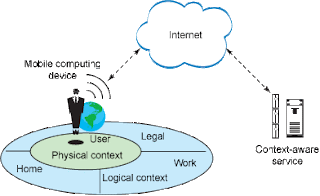An important aspect of pervasive computing is context-awareness, which has to do with delivering relevant data and services to users based on their current environment. Let's say you're at a mall. If you're not a diver, a message informing you that a store is giving a 60% discount on scuba diving equipment would be of no interest to you. In fact, it might even be annoying to receive messages about things you have no interest in.
On the other hand, if you play tennis and you receive a message that you'll receive 20% discount on a tennis racket if you go to a certain store and show them this message would definitely interest you. Likewise, an alert about a special offer at a nearby ice cream parlor would be welcome on a very hot day.
Context-aware service is about delivering data and services that is relevant to where you are and what you're doing. Often, location plays an important role in determining context.
Dey (2001) defines context as "any information that can be used to characterise the situation of an entity. An entity is a person, place, or object that is considered relevant to the interaction between a user and an application, including the user and applications themselves". Any piece of information that can be used to characterise the situation of a participant in an interaction is context.
Also according to Dey, “a system is context-aware if it uses context to provide relevant information and/or service to the user, where relevancy depends on the user’s task”. There are three categories of features for a context-aware application:
- presentation of information and services to a user,
- automatic execution of a service for a user, and
- tagging of context to information to support later retrieval.
Context management involves the task of context modelling, acquisition and provisioning, where context relates to relevant environmental information of an entity. Schilit et al (1994) identified three important aspects of context:
- where you are,
- who you are with,
- what resources are nearby.
Context aware systems are classified according to their adaptation of these three aspects. Any changes to any of these three factors would have an impact on the adaptation of a context-aware application, which must be capable of examining the current context and adapt accordingly.
Source
- A.K. Dey, "Understanding and Using Context", Personal and Ubiquitous Computing, Vol. 5 Issue 1, February 2001
- B. Schilit, N. Adams, R. Want, "Context-Aware Computing Applications", Proc. of the Firs Workshop on Mobile Computing Systems and Applications, California, USA, 8-9 December, 1994





No comments:
Post a Comment